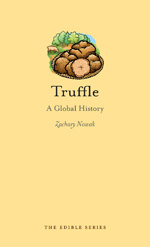Review: Truffles May 14, 2015
Author: Beach Combing | in : Contemporary , trackbackTruffles… Where to even begin? Think a five thousand Euro lump of tuber magnatum sweating in your hand; black truffles grated onto steaming pasta and stirred gently in; truffle salt mixed into white basmati rice; a bottle of truffled oil left open to spread that magic odour in a bedroom; the siren’s sweet sound as the carabinieri come to arrest some truffle adulterators; or a Piedmont peasant screaming as his truffle pig chews off a digit while getting at ‘the treasure’… Beach would love to like mushrooms but he just doesn’t: the taste is interesting, the texture disgusting. Yet somehow truffles work for him. By hiding under trees, working together with the tree’s roots, the truffle escapes the foul viscousness of its above ground and weaker-minded inbred country cousins…
Reaktion has, in the last, five years brought out about 40 books on different foods in its Edible Series: pizza, bread, cheese… (We’ll come to truffles in a minute.) They are small hardback volumes of about 120 pages, filled, this being Reaktion, with luscious pictures, and giving an outline of the history of this or that food. Beach has read approx half of these books and the series is worthwhile but uneven: curiously the more prestigious contributors have produced some of the least interesting books. In fact, none of the books really stood out until Truffles (Zachary Nowak 2015) arrived in yesterday’s post.
ZN has taken it upon himself to write a history of the tastiest tubers in the world from the second millennium BC, when Syrian truffles turn up in a clay tablet letter, to the modern truffle wars in Italy and France. There are two reason the book works so well. First, ZN does not write like an academic, something which stultifies a little some of the other books in the series: the dreadful word ‘foodways’ does not appear in Truffles, for example. His prose style is much closer to that of Mark Kurlansky or John Reader. Some of the sentences and conceits might leave you bewildered, but you will never be bored. It helps, too, that the author is obviously enjoying himself.
Second, ZN has found the perfect structure for a book like this. The ‘obvious’ thing to have done would have been to list truffle sources and bulk out the volume with food sociology like foam chips in a don’t-drop package. Instead, we have a history of western food (ancient, Columbian exchange, French food revolution etc) with truffles situated in each phase: general food history becomes a template, then. With some foods this wouldn’t work because they have not been around long enough: e.g. icecream. With some foods it would not work because there is just too much to say and the template would crack down the middle: e.g. bread. With truffles it means entertainment and understanding.
As noted above Reaktion have got themselves a well-deserved reputation for their illustrations. In this book the illustrations are mouth-watering, this is truffles we are talking about, after all. However, they are sometimes a little ill matched to the subject matter. This is likely because ancient, medieval and early modern pictures of truffles are so difficult to come by? Still it creates some jarring if entertaining moments. Beach’s favourite image was a photograph of what looks like a French farmer, with a jersey knitted in the decades after the Second World War, truffles in hand, with the caption: ‘the Savoy sent out truffle-hunters and their dogs to monarchs across Europe’… . Still, let nothing detract from the best book yet to appear in Reaktion’s Edible series (at least the best book read by this blogger): if you haven’t yet put a truffle in your mouth, your adventure with taste should begin here. Beach, meanwhile, has been spurred to look at the sources for truffle history (many other posts, many other days).
Beach is always looking for well-written books on unusual subjects: drbeachcombing AT yahoo DOT com



